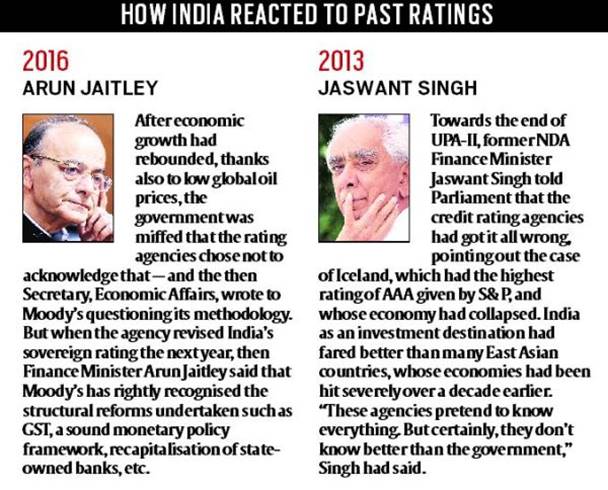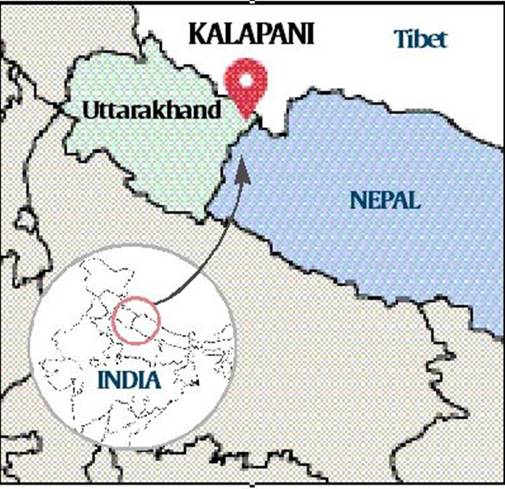



Explained: How global credit ratings work
- India’s sovereign credit rating from Moody’s is now Baa2, with this Indian economy outlook is cut from ‘stable’ to ‘negative’.
- Risks to economic growth
- Prospects of a more entrenched slowdown
- Weak job creation
- Credit squeeze being faced by Non-Banking Finance Companies
- Political uncertainty can trigger a sovereign rating downgrade. In August 2011, S&P cut the highest rating (AAA) of the US citing rising debt levels and political risks.
- Scale the financials and business models of companies
- Economic management by sovereign governments
- Rate instruments such as bonds, debentures, commercial papers, deposits, and other debt offerings of companies or governments to help investors make informed decisions.
- A better rating helps raise funds at a cheaper rate.
- Investors or banks abroad may well seek higher interest rates because of weak prospects.
- Firms and many governments that borrow from the international markets too are mindful of rating downgrades.
- India has not issued a bond or raised money directly in the international market so far, which means that to a good extent, a downgrade has limited impact.
- The impact is felt almost fully by private firms or state-owned companies, which raise foreign currency funds.
- In the run-up to India’s balance-of-payments crisis in 1991, the agencies swiftly downgraded the sovereign rating, thus reducing the country’s ability to raise money abroad through public sector oil companies or banks for short periods to buy oil or to pay for imports.
- In 1998, when India announced that it had carried out nuclear tests in Pokhran, the ratings agencies were quick to react again, affecting borrowings.
- Credit agencies had given highest ratings to banks, which defaulted during 2008 financial crisis leading to questioning on their methodology.
- Government has earlier complained that countries with higher levels of debt and a weak fiscal have managed better ratings.

Reference: https://indianexpress.com/article/explained/explained-how-global-credit-ratings-work-moodys-6113409/
The new political map of India, recently released by the government to account for the bifurcation of Jammu and Kashmir, has triggered fresh protests over an old issue in Kathmandu.
- Nepal’s western boundary with India was marked out in the Treaty of Sugauli between the East India Company and Nepal in 1816.
- Nepali authorities claimed that people living in the low-density area were included in the Nepal Census until 58 years ago.
- Nepalese Foreign Minister claimed that the late King Mahendra had “handed over the territory to India”.
- A committee to “Study the boundary with India” claimed that India had “occupied” an additional 62 sq km land.
Kalapani:
- Mapped within Uttarakhand, this 372-sq km area border far-west Nepal and Tibet.
- Apart from Kalapani, another unresolved issue involves a vast area along the Nepal-Uttar Pradesh border.

- Government told journalists that the recently released map after delineation of J& K “accurately depicts the sovereign territory of India”.
- The Nepal government described India’s decision as “unilateral” and claimed that it will “defend its international border”.
- India has assured that it would not occupy even an inch of Nepal.
- Government assured that the boundary delineation exercise with Nepal is ongoing under the existing mechanism.
- India will find a solution through dialogue in the spirit of our close and friendly bilateral relations.
- 98 per cent of border-related matters with Nepal had been settled by India.
Ministry of Commerce and Industry allocated a separate Harmonised System (HS) code for Khadi.
- The Harmonised System, or simply ‘HS’, is a six-digit identification code developed by the World Customs Organization (WCO).
- It is a multipurpose international product nomenclature.
- It is called the “Universal Economic Language” for goods.
- Over 200 countries use this system as a basis for their customs tariffs, gathering international trade statistics, making trade policies, and for monitoring goods.
- This system currently comprises of around 5,000 commodity groups, each identified by a unique six-digit code that has numbers arranged in a legal and logical structure, with well-defined rules to achieve uniform classification.
- This move is expected to boost Khadi exports in the upcoming years.
- In 2006, the government had given the MSME-controlled Khadi and Village Industries Commission (KVIC) the Export Promotion Council Status (EPCS).
- The absence of a separate HS code hindered Khadi from achieving its full potential, as its exports were difficult to categorise and calculate.
- it will also help us in planning export strategies.
The Kartarpur Corridor is open. The first jatha of over 500 Indian pilgrims crossed the 4.2-km stretch from Gurdaspur to Gurdwara Darbar Sahib in Pakistan’s Kartarpur.
- It was here on the banks of the river Ravi that Guru Nanak laid the foundations of a new faith in a commune he set up.
- The supreme purpose of human life is to gain enlightenment or a state of union with God.
- He did not favour a life of renunciation.
- He felt that you can take up additional responsibilities after liberation, for then you know that your life is not meant for you alone but for the welfare of others.
- He preached—“naamjapo, kirrtkaro, wand chhako (worship, work, and share)” — as the path to liberation.
- Nanak believed in the importance of singing the praises of God as a way to gain liberation.
- He set up a ‘dharamsal’ (a place where dharma or merit is earned later known as Gurudwara), where he and his followers would sing his compositions in the morning and evening.
- Nanak also introduced his followers to ‘katha’, exposition of his composition or other issues.
- Nanak started the concept of ‘langar’, a community meal prepared in a community kitchen where everyone would sit on the floor and eat together regardless of their social background.
- The distinctive feature of Sikh identity — Service before Self — was formulated by Guru Nanak.
- Nanak preached that every human being, regardless of his family, caste, creed or gender, could attain liberation by following the three principles of work, worship and sharing.
- His programme was of universal liberation and redemption.
- Nanak gave the three Gs — Gurdwara, the Granth, and the Guru himself — that underpin the Sikh faith.
The draft code on social security, which subsumes eight existing laws covering provident fund (PF), maternity benefits and pension, is being further worked upon after a recent round of public consultations.
- It seeks to amalgamate a clutch of existing laws and proposes several new initiatives including universal social security for unorganized sector workers, insurance, and health benefits for gig workers including the Ola and Uber drivers.
- It also proposes corporatization of existing organizations like EPFO and ESIC headed by people other than the labour minister.
- Insurance, PF, life cover for unorganized sector employees.
- Millions of gig workforce in India, often referred as lonely in the workplace, may soon get life and disability insurance, health and maternity benefits.
- Every woman shall be entitled to, and her employer shall be liable for, the payment of maternity benefit at the rate of the average daily wage for the period of her actual absence.
- Trade unions are against the proposal for provident fund, pension and insurance funds to be administered by a central board.
- They are against national pension scheme that employees can opt for.
- This code did not include right to social security for all.

Former Chief Election Commissioner Tirunellai Narayana Seshan, who had become an icon of Indian bureaucracy for ushering in tectonic reforms in the country's electoral process during his tenure in the nineties, died.
- He made the EC powerful within the existing laws and pleading for electoral reforms.
- Seshan served as a CEC from 1990 to 1996.
- He implemented the election manual in letter and spirit by implementing the Model Code of Conduct
- Introduction of voter ID cards
- Enforcing limits on poll expenses
- Elimination of several malpractices like distribution of liquor, bribing voters, ban on wall writing, use of loud speakers, use of religion in election speeches.
- Introduced election observers and also forced the candidates to keep accurate accounts of campaign expenses.
- Under his strict watch, a serving Governor who campaigned for his son had to resign.
- He recommended to Prime Minister PV Narasimha Rao to sack two of his ministers – Sitaram Kesri and Kalpanath Rai – for allegedly influencing the voters.
- The Chief Secretary of UP was taken to task for issuing an advertisement in a newspaper at the cost of public exchequer.
- He conducted elections with two principles: “zero delay and zero deficiency.”
The Election Commission of India
- It is an autonomous constitutional authority responsible for administering election processes in India at national, state and district level.
- It administers elections to the Lok Sabha, Rajya Sabha; state Legislative Assemblies, state legislative Councils, and the offices of the President and Vice President of the country.
- The Election Commission operates under the authority of Constitution per Article 324, and subsequently enacted Representation of the People Act

© 2025 iasgyan. All right reserved